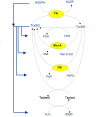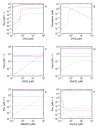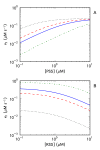The logic of kinetic regulation in the thioredoxin system
- PMID: 21266044
- PMCID: PMC3045320
- DOI: 10.1186/1752-0509-5-15
The logic of kinetic regulation in the thioredoxin system
Abstract
Background: The thioredoxin system consisting of NADP(H), thioredoxin reductase and thioredoxin provides reducing equivalents to a large and diverse array of cellular processes. Despite a great deal of information on the kinetics of individual thioredoxin-dependent reactions, the kinetic regulation of this system as an integrated whole is not known. We address this by using kinetic modeling to identify and describe kinetic behavioral motifs found within the system.
Results: Analysis of a realistic computational model of the Escherichia coli thioredoxin system revealed several modes of kinetic regulation in the system. In keeping with published findings, the model showed that thioredoxin-dependent reactions were adaptable (i.e. changes to the thioredoxin system affected the kinetic profiles of these reactions). Further and in contrast to other systems-level descriptions, analysis of the model showed that apparently unrelated thioredoxin oxidation reactions can affect each other via their combined effects on the thioredoxin redox cycle. However, the scale of these effects depended on the kinetics of the individual thioredoxin oxidation reactions with some reactions more sensitive to changes in the thioredoxin cycle and others, such as the Tpx-dependent reduction of hydrogen peroxide, less sensitive to these changes. The coupling of the thioredoxin and Tpx redox cycles also allowed for ultrasensitive changes in the thioredoxin concentration in response to changes in the thioredoxin reductase concentration. We were able to describe the kinetic mechanisms underlying these behaviors precisely with analytical solutions and core models.
Conclusions: Using kinetic modeling we have revealed the logic that underlies the functional organization and kinetic behavior of the thioredoxin system. The thioredoxin redox cycle and associated reactions allows for a system that is adaptable, interconnected and able to display differential sensitivities to changes in this redox cycle. This work provides a theoretical, systems-biological basis for an experimental analysis of the thioredoxin system and its associated reactions.
Figures





Similar articles
-
Mechanistic characterization of the thioredoxin system in the removal of hydrogen peroxide.Free Radic Biol Med. 2015 Jan;78:42-55. doi: 10.1016/j.freeradbiomed.2014.10.508. Epub 2014 Oct 29. Free Radic Biol Med. 2015. PMID: 25451645 Free PMC article.
-
Functional analyses of ancestral thioredoxins provide insights into their evolutionary history.J Biol Chem. 2019 Sep 20;294(38):14105-14118. doi: 10.1074/jbc.RA119.009718. Epub 2019 Jul 31. J Biol Chem. 2019. PMID: 31366732 Free PMC article.
-
Protein disulfide-isomerase is a substrate for thioredoxin reductase and has thioredoxin-like activity.J Biol Chem. 1990 Jun 5;265(16):9114-20. J Biol Chem. 1990. PMID: 2188973
-
Properties and biological activities of thioredoxins.Annu Rev Pharmacol Toxicol. 2001;41:261-95. doi: 10.1146/annurev.pharmtox.41.1.261. Annu Rev Pharmacol Toxicol. 2001. PMID: 11264458 Review.
-
Computational models as catalysts for investigating redoxin systems.Essays Biochem. 2024 Apr 30;68(1):27-39. doi: 10.1042/EBC20230036. Essays Biochem. 2024. PMID: 38356400 Review.
Cited by
-
Roles of peroxiredoxins in cancer, neurodegenerative diseases and inflammatory diseases.Pharmacol Ther. 2016 Jul;163:1-23. doi: 10.1016/j.pharmthera.2016.03.018. Epub 2016 Apr 26. Pharmacol Ther. 2016. PMID: 27130805 Free PMC article. Review.
-
The thioredoxin system and not the Michaelis-Menten equation should be fitted to substrate saturation datasets from the thioredoxin insulin assay.Redox Rep. 2016 Jul;21(4):170-9. doi: 10.1179/1351000215Y.0000000024. Epub 2016 Mar 21. Redox Rep. 2016. PMID: 26102065 Free PMC article.
-
Effects of Zinc Phthalocyanine Photodynamic Therapy on Vital Structures and Processes in Hela Cells.Int J Mol Sci. 2024 Oct 3;25(19):10650. doi: 10.3390/ijms251910650. Int J Mol Sci. 2024. PMID: 39408981 Free PMC article.
-
The glutaredoxin mono- and di-thiol mechanisms for deglutathionylation are functionally equivalent: implications for redox systems biology.Biosci Rep. 2015 Feb 25;35(1):e00173. doi: 10.1042/BSR20140157. Biosci Rep. 2015. PMID: 25514238 Free PMC article.
-
Nuclear Factor (Erythroid-Derived 2)-Like 2 and Thioredoxin-1 in Atherosclerosis and Ischemia/Reperfusion Injury in the Heart.Antioxid Redox Signal. 2017 Apr 20;26(12):630-644. doi: 10.1089/ars.2016.6795. Epub 2017 Jan 18. Antioxid Redox Signal. 2017. PMID: 27923281 Free PMC article. Review.
References
-
- Vlamis-Gardikas A. The multiple functions of the thiol-based electron flow pathways of Escherichia coli: Eternal concepts revisited. Biochim Biophys Acta. 2008;1780:1170–1200. - PubMed
-
- Holmgren A, Bjornstedt M. Thioredoxin and thioredoxin reductase. Methods Enzymol. 1995;252:199–208. full_text. - PubMed
Publication types
MeSH terms
Substances
LinkOut - more resources
Full Text Sources

